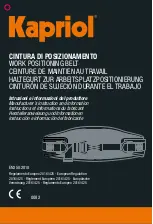
Operation and Installation Manual PBTC-200-E
21-54C3-7D0001/A
05/2023-EHT-441168
Notice:
Technical data subject to change without notice.
No claims for damage arising from alternations, errors or misprints shall be allowed.
Page 17 / 40
9
Installation and Assembly
Required Tools / Equipment
The following tools and equipment are required for installa-
tion of the PBTC-200-E:
Wire cutters
Flat screwdriver 2.5 mm
Flat screwdriver 3.5 mm
Electricians screwdriver
4 mm hex wrench
Tape measure
Utility knife
Needle-nose pliers (2x)
Adjustable wrench (2x)
Tongue and groove pliers
Safety Instructions
WARNING
Risk of fire or electrical shock due to electric trace
heating system.
De-energize all power circuits before installation or
servicing. Always use ground fault equipment protec-
tion with the trace heating system.
Keep the trace heater ends dry before and during in-
stallation. Observe the design guide of the trace heat-
ing system.
Double-check that all power circuits are de-energized be-
fore you begin your work.
Make sure that you do not exceed the maximum heating
circuit length for the trace heater type you use.
Observe the bending radius of each type of trace heater.
Do not bend on the narrow axis.
To avoid short circuits, do not connect the trace heater bus
wires together. Installing the End seal properely
Keep all components and the trace heaters dry before and
during installation.
Installing the Heating Cable
CAUTION
Risk of injury and/or material damage. Never step on or
drive over the trace heater. Do not use it as a loop for
stepping on.
Install the heating cable in a straight line along the pipe if
possible
If possible, install the heating cable in the lower half of the
pipe, but not at the lowest point
If necessary, return the heating cable loop to the heating
cable at the greatest possible distance
Install the Resistance Temperature Device directly on the
pipe
Install the Resistance Temperature Device in the lower
area of the pipe cross section
Install the Resistance Temperature Device at the greatest
possible distance from the heating cable
Observe additionally required heating cable lengths (as-
sembly of connections, T-branches and end terminations,
each approx. 0.5 m)
Avoid damage to the heating cable and the Resistance
Temperature Device: no bending, pinching or pulling over
sharp edges
2
3
2 x
1
2 x
















































